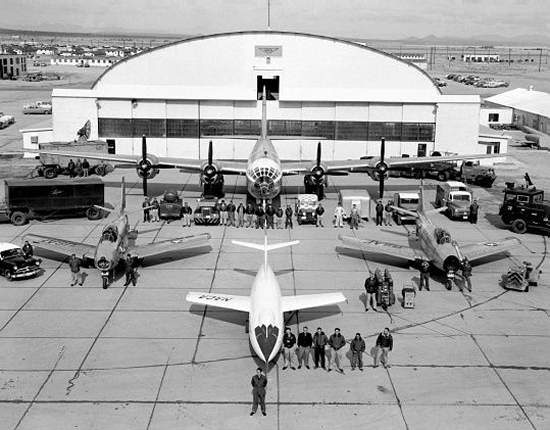|
||||||||||
|
|
||||||||||
|
||||||||||
|
|
||||||||||
To investigate swept wing technology, the Navy and NACA had contracted the Douglas Aircraft Company to build the D-558-2 Skyrocket. The aircraft built on the success of the earlier D-558-1, but was fitted with a powerful rocket engine and wings swept back at 35° to explore the characteristics of swept wings at supersonic speeds. The program was quite successful, and the three aircraft had completed over 230 flights for the Navy and NACA by November 1953. Among its achievements were world records for altitude (83,235 ft) and speed (Mach 1.88), the latter being even more remarkable considering that the Skyrocket was only designed to reach Mach 1.6.
Nevertheless, NACA flight test pilot Scott Crossfield believed he could push the D-558-2 even further and reach the next major milestone of Mach 2. Adding to the challenge was the fact that rival test pilot Chuck Yeager was poised to achieve the same mark shortly in the X-1A, an improved model of the X-1 built specifically for Mach 2 flight. This friendly rivalry inspired Crossfield and NACA ground crew to work feverishly, tweaking the Skyrocket to coax every ounce of performance out of it they could. Their modifications included engine adjustments to increase thrust and fuel efficiency, taping over seams, and even covering the plane with a coat of wax hoping to reduce skin friction drag.

Crossfield's first attempt came on 14 October 1953, exactly six years to the day after Yeager's Mach 1 flight. While Crossfield managed to set a new speed record of Mach 1.96, he couldn't quite get the Skyrocket to Mach 2. With time running out, Crossfield made one final attempt on 20 November despite suffering from the flu. On this attempt, he and NACA engineers had planned a precise flight profile including release from the B-29 mothership at 32,000 ft preceeding a rapid climb to 72,000 ft. At that altitude, Crossfield pushed the plane into a shallow dive. As he passed through 62,000 ft, the Machometer finally revealed what he had hoped for, a speed of Mach 2.005. The pleased pilot glided his unpowered Skyrocket back to Earth where he made a victory roll before landing at Rogers Dry Lake.
Just three weeks later, Chuck Yeager got his chance to regain the crown as fastest man alive when he set a new
speed record of Mach 2.44 at 76,000 ft on 12 December 1953. Although Crossfield had been the first to fly at
Mach 2, Yeager was the first to do so in level flight. Scott Crossfield had more chances at glory, however, for he
later became chief engineering test pilot for North American Aviation. In this position, he participated in early
demonstration flights of the X-15 at speeds up to Mach 3. In
fact, Scott Crossfield was one of the most experienced experimental test pilots in history, having flown the X-1,
XF-92, X-4, X-5, D-558-1, D-558-2, and X-15. He finished his
career as a technical adviser to the U.S. House of Representatives Committee on Science and Technology.
Crossfield's record-setting D-558-2 is now on display at the National Air & Space Museum in Washington DC.
- answer by Joe Yoon, 8 December 2002
Related Topics:
Who was the first woman to break the sound barrier?
Who was the first Brit to break the sound barrier, and when did it occur?
When did Russia first break the sound barrier? Who did it and in what plane?
Read More Articles:


|
Aircraft | Design | Ask Us | Shop | Search |

|
|
| About Us | Contact Us | Copyright © 1997- | |||
|
|
|||